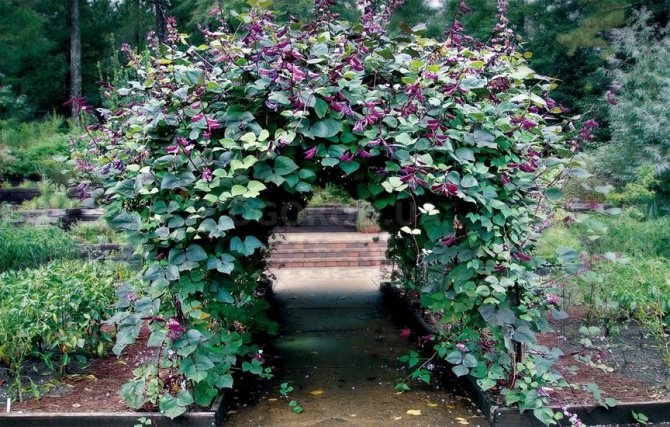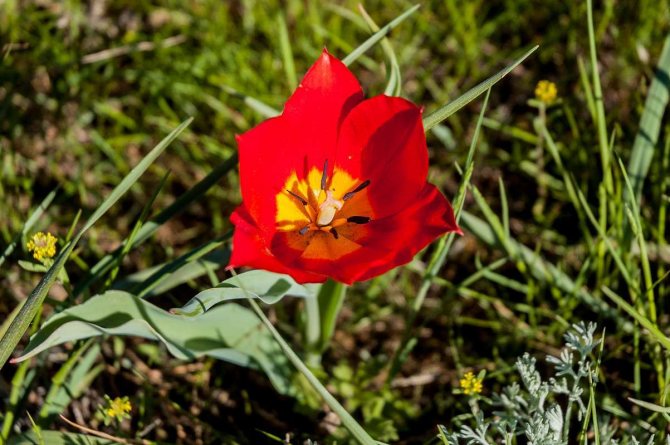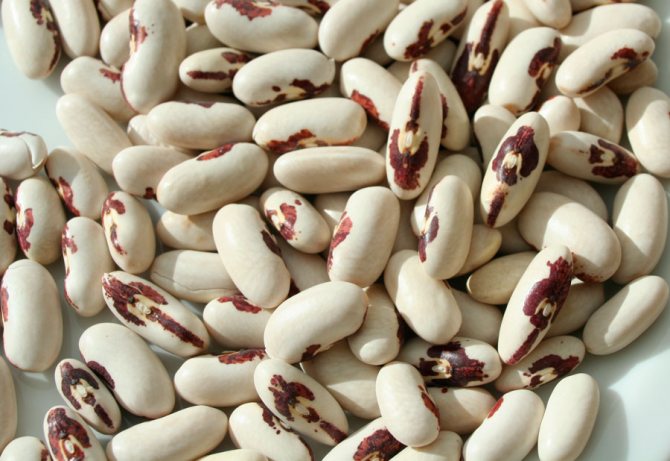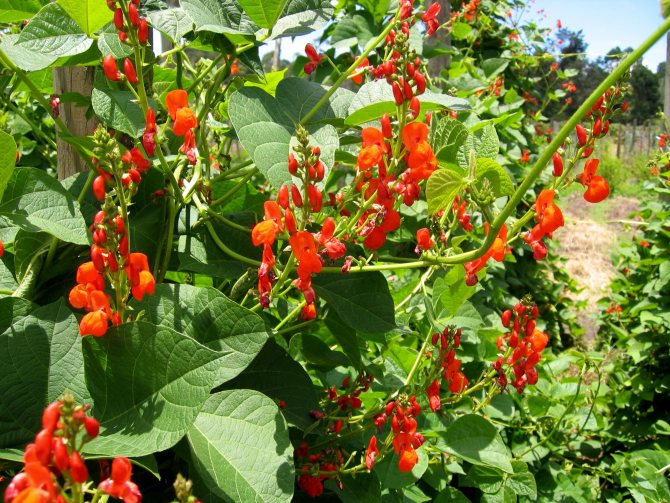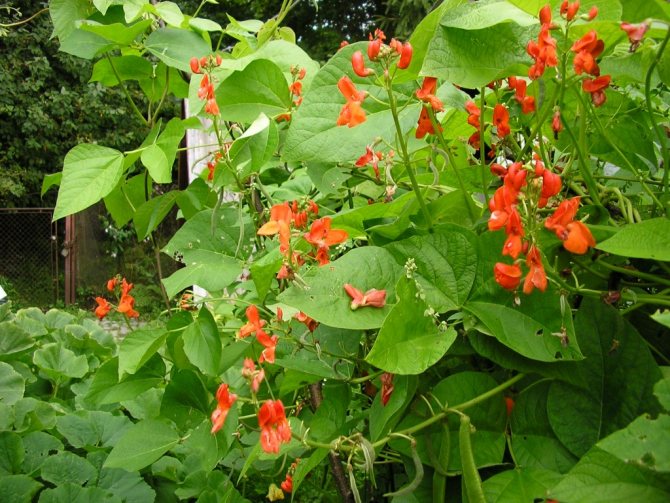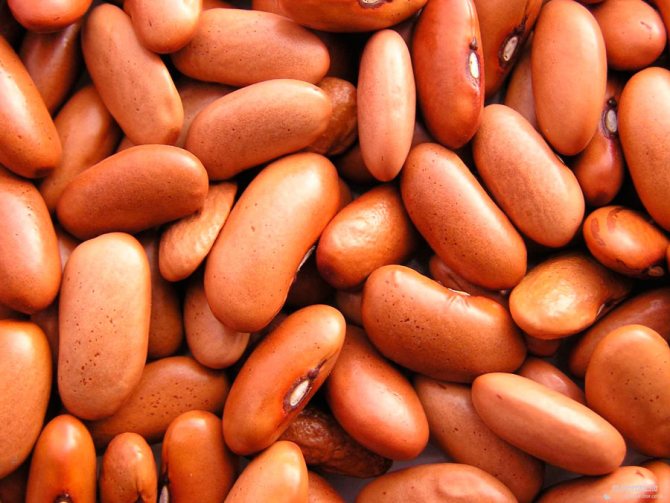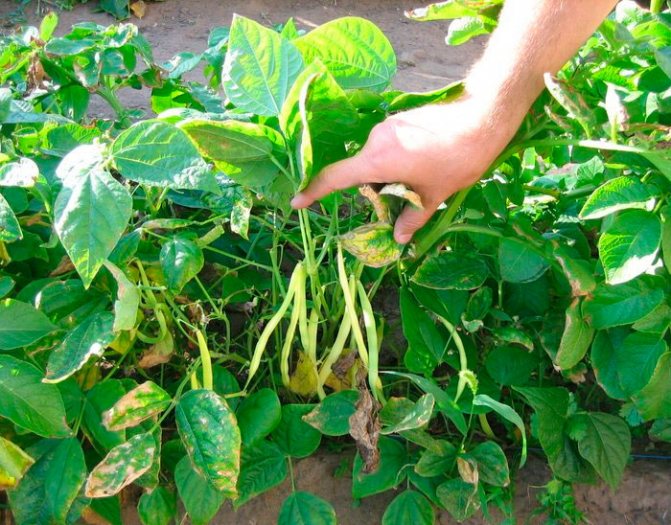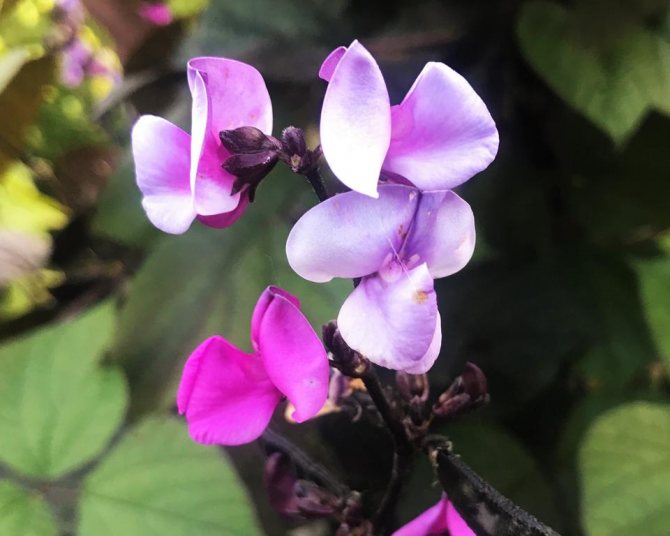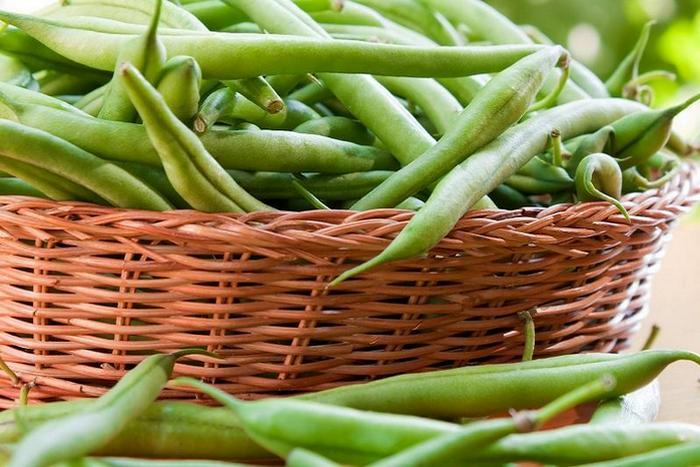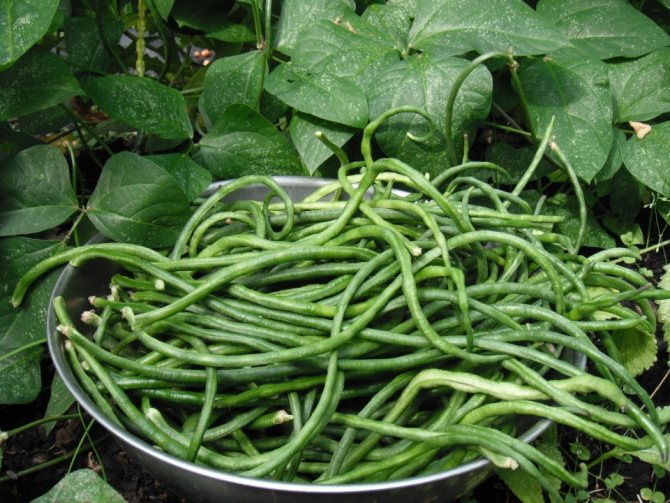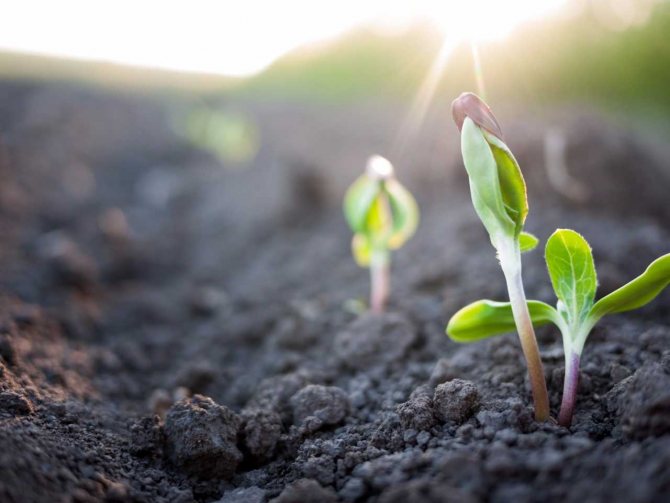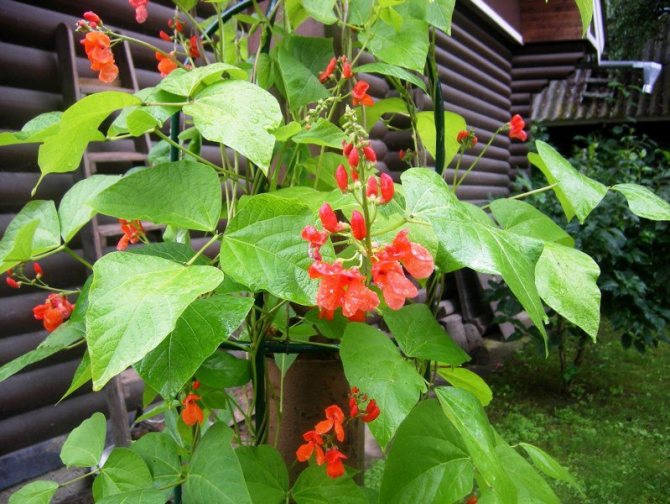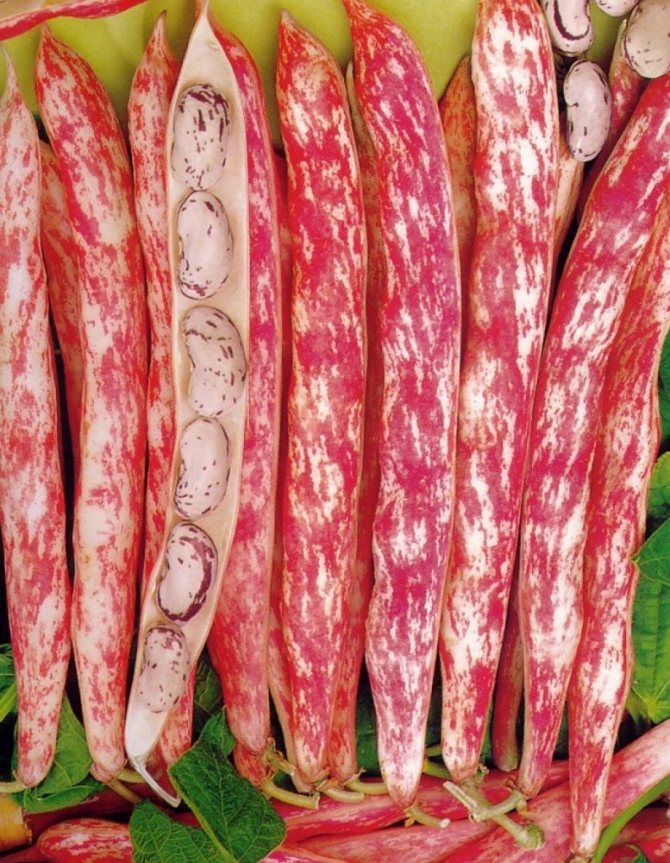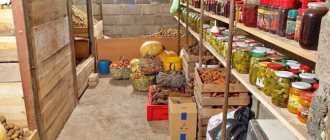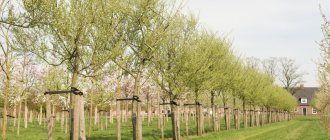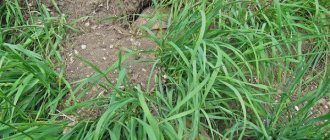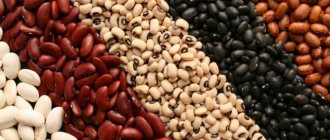Description and characteristics of the plant
Most often on our sites you can find decorative beans with purple and bright red flowers. But the variety of its colors is much richer. It is believed that the purple color of the flowers is inherent in several varieties of beans, while the fiery red is a separate variety. Currently, it is believed that this is not entirely true: the variety of new varieties covers all conceivable color variations.
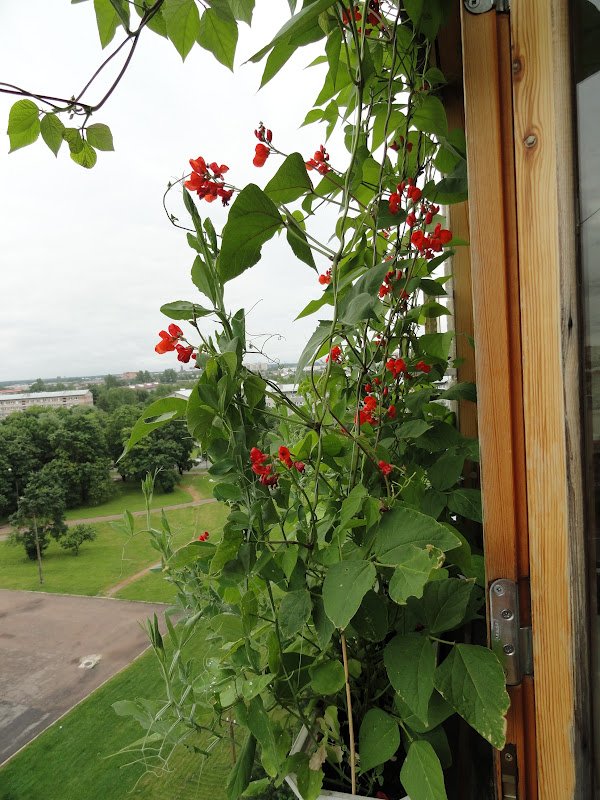
Beans are great for vertical gardening
Beans grow very quickly, many varieties reach a height of 5 m, and throughout this stretch the shoots are trying to grab onto something. This is a thermophilic culture, but it does not require special conditions, it grows well in any sunny area. In the shade it feels a little worse, but it also pleases the owner with very beautiful flowers. The fruits of many varieties are edible, however, few of the summer residents eat them, preferring to plant grain or asparagus varieties separately on a small garden bed.
Like any other beans, ornamental beans saturate the soil around themselves with nitrogen, absorbing it from the depths of the soil and from the air and transferring it into digestible compounds that accumulate on the root nodules. In this regard, at the end of the season, the plants are not pulled out: they are cut off at the soil surface, leaving the roots in place.
Potatoes planted nearby significantly increase their yield due to the property of beans to improve soil fertility. And the green mass of decorative beans removed in autumn is sent to the compost pit, where it enriches the composition of the collected plant waste with a large amount of nutrients.
Solanaceous plants growing near beans are not affected by late blight. The Colorado potato beetle does not like its aroma.
Homeland of decorative beans - Latin America, its original name is translated as "sailing ship", which is due to the shape of the flower. Ripe fruits are large, rough beans. It is them that are collected in order to repeat the planting the next year or build a flowering wall on a new site.
Video: All About Beans Turkish Beans
Let's summarize
Ornamental beans are an entertaining crop that not only pleases the gardener's eye, but can also bring you nutritious beans that are high in protein and fiber. As they say, it provides food for both body and soul. The valuable product of this culture can be stored in winter or used fresh, and the flowers should be enjoyed during the long part of summer.
Video - About ornamental beans
If you decide to plant not only a beautiful, but also a productive plant on the site, climbing beans are perfect for this role.
To begin with, remember that curly beans, like bush beans, are divided into two main types:
— grain (shelling) beans. The fruits are the well-known beans-beans. A shelling bean pod has a parchment layer inside that fills the space between the beans. This makes the pod itself tough and is generally not eaten.
— asparagus (sugar, green beans)... The main value of green beans, as the name implies, is in the pods. There is practically no parchment layer between the beans in sugar beans, so the shoulder blades grow tender, juicy, crunchy, suitable for freezing.Eat pods of asparagus beans in an immature state. However, if you keep them on the plant to biological maturity, you can harvest beans. True, these grains will be inferior in size to the grains of shelling beans.
There are semi-sugar varieties of curly beans - a cross between grain and green beans. The parchment layer in such varieties is present in small quantities, therefore, at a young age, the pods can be eaten as asparagus. As they mature, the pods become stiffer, and in the future it is grown as a shelling, for the sake of the grains.
Planting ornamental beans
In most cases, beans are grown by sowing seeds directly into open ground. After all, there is not much sense in spending energy on seedlings here, beauty can wait for warm days, and such beans are not specially grown for food. However, the seedling option also exists, they resort to it in regions with a harsh climate and in those cases when you want to create a beautiful wall in the country as early as possible. True, you will have to tinker with the seedlings, remembering, among other things, that the beans are extremely painful for any transplant.
Video: Dolichos bean bushes on the site
Landing dates
It is not possible to sow seeds in open ground very early, the soil should be warmed up for sowing: the seeds begin to germinate at a soil temperature of 8–10 ° C, and the seedlings are very sensitive to frost and die at -1 ° C. The optimum temperature for its growth is considered to be 20–25 ° C. In the central region, planting dates are mid-May, in the north - early June. In the south, all kinds of beans are sown in April. If seeds are sown in cold soil, their germination decreases sharply, and sometimes they completely die. A rough guideline is the time when cucumbers are sown, which, like beans, are afraid of frost.
They begin to grow decorative beans for seedlings at the very end of March or early April, in the northern regions - towards the end of April. If it turns out that the sowing was carried out too early and the seedlings have outgrown, you will have to arrange a support for it, to which long stems are tied. To this end, you can gently stick, for example, a pencil next to the sprout.
Planting seedlings
Seedlings will have to stay at home for about a month, they will normally grow in soil of any composition, except clay, but it is better to mix turf and sand in a ratio of 2: 1 and add a handful of wood ash to a bucket of mixture.
It is imperative to sow seeds for seedlings in individual pots: beans do not tolerate transplanting with root damage. You can also use disposable ones with a removable bottom, but the best option would be peat ones - then planting in open ground will be completely painless. You can also use large peat tablets.
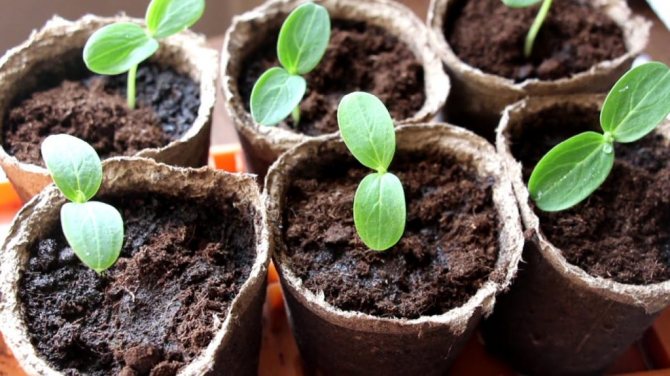

The best option for growing bean seedlings is peat pots
Bean seeds are large, and before sowing, they are easy to calibrate, discarding the smallest and most infested with pests. Then it is recommended to soak the seeds in water until they swell (for 12-16 hours), without waiting for pecking.
Recent Entries
5 of my favorite tomato varieties that are great for pickling 7 super early and delicious potatoes to plant in 2020 6 rare 2020 tomato varieties that will bring you a decent harvest
Some gardeners pre-pickle them in a solution of potassium permanganate and even soak them in growth stimulants. All this, of course, can be done, but it is not necessary to engage in optional operations in the case of growing an ornamental crop.
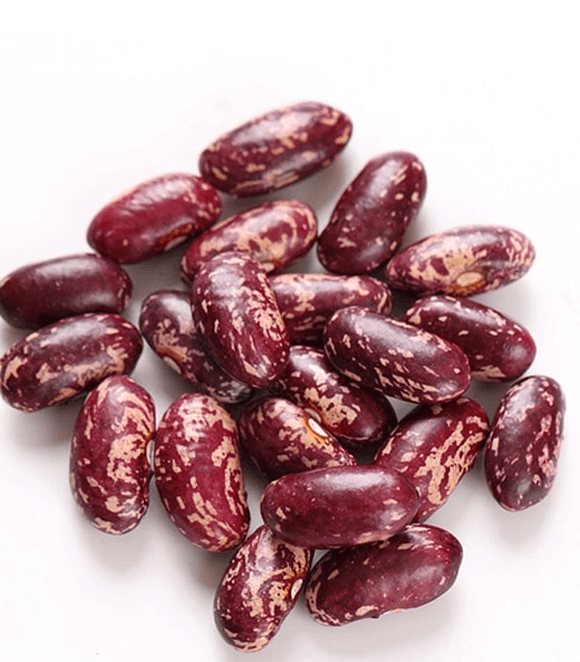

Ornamental bean seeds come in a variety of colors, but they are always large and easy to handle.
The beans are sown to a depth of about 2 cm. Usually it grows well, so it is enough to put one bean in a pot or a tablet, but if there are a lot of them and there are doubts about germination, you can spread it out in 2-3 pieces, and then carefully remove the excess shoots.
The temperature at which the seedlings should be grown is 18-22 ° C, but after the emergence of seedlings it should be reduced by several degrees for 3-4 days. Growing seedlings does not require any special worries, except for periodic watering. Bushes do not have to be shaped by pinching or trimming. No additional feeding is required for this month.
If the soil was very thin and it turns out that the seedlings are growing slowly, you can water it with an infusion of wood ash.
It is possible to transplant seedlings into the garden no earlier than two real leaves develop. It should not be kept at home for too long, but if the transplant is carried out with a peat pot, then there is no risk. Only a week before planting, it is necessary to prepare the bushes, taking them periodically to the balcony and accustoming them to fresh air.
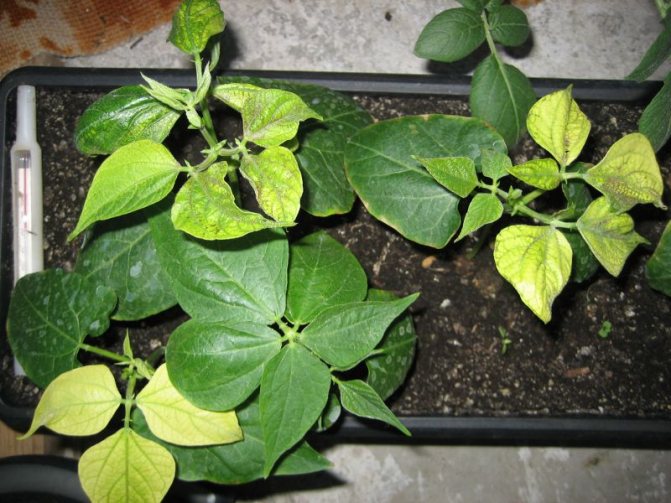

A common bean box is not the best option: it will be very difficult to remove the seedlings without damaging the roots
Planting seedlings in the garden
Ornamental beans are less demanding on conditions than vegetable varieties. But still, the bed should be prepared in advance by adding the usual doses of fertilizers. It can be humus or compost, but not fresh manure. Any mineral compositions with an emphasis on phosphorus and potassium are also suitable: a lot of nitrogen is not required in beans. This item causes excessive growth of vegetative mass to the detriment of intense flowering.
If there is clay on the site, sand should be added when digging, if the soil is too acidic - chalk.
The scheme for planting decorative beans is any, since its main purpose is to decorate the site. Therefore, the owner decides for himself whether it will be a garden bed or one row along a wall or a fence, but a distance of at least 20 cm should be left between the plants, and preferably 30–40 cm. If there are several rows, then between them leave from 40 to 50 cm, in depending on how it turns out to build the supports.
The technique of planting seedlings is the usual: in the selected places, holes are dug in the size of a pot and the seedlings are buried in them almost without deepening, after which they are plentifully watered with warm water and mulch the soil.
Sowing seeds in the ground
Sowing seeds directly into the garden is the most common way to plant ornamental beans, and this is most often done. In the case of light and warm soil, the beans are sown on a flat surface.
If groundwater is close, they build an elevated bed.
The sowing scheme is the same as when planting seedlings: distances from 20 to 40 cm are left between the holes. A denser planting gives a solid blank wall, but the plants develop worse, they do not bloom so gracefully. 2-3 beans are sown into each hole to a depth of 1.5–2 cm, then abundantly water the garden bed from a watering can with a strainer and mulch the soil with any loose material. If the threat of frost persists, crops are temporarily covered with spunbond. Excess seedlings are carefully cut off a few days after their appearance.
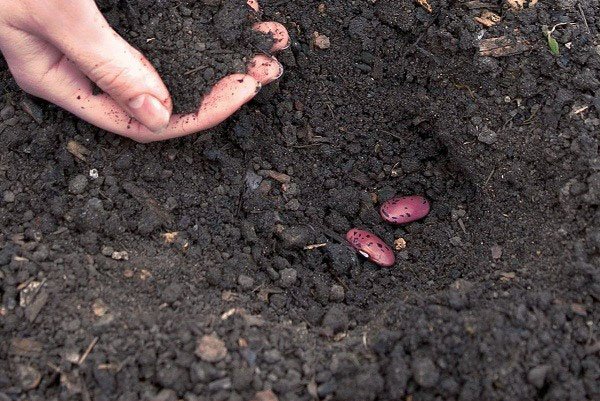

Bean seeds are not sown very deeply, you can do 2-3 pieces per hole
Is it a food or just a flower crop
I will say right away: it all depends on the variety. There are beans, which all go into cooking (both pods and seeds, that is, beans), there are varieties with non-edible pods, but there are also exclusively ornamental plants (some purple beans).
The main advantages of such beans are its pickiness and weaving. This vine is allowed on gazebos, fences, walls, trees, and special supports.
By the way, the support for the plant must be strong - the stem of each bean grows up to 5 meters, and if the crop is densely planted, not every rope will withstand it.
Many grow it in the garden, especially next to potatoes.Firstly, it is believed that such a garden "companion" protects potatoes from late blight, and secondly, a lot of nitrogen is collected near the roots of this plant, which this very potato successfully consumes all season. Finally, it is good to rake the fallen foliage of the beans into the compost.
The most popular varieties of garden beans
The shades of the flowers, the size and color of the pods - these are the differences between the different varieties of beans. Some may be asparagus and some may be peelable (regular). As for the flavor of the beans, it is approximately the same for all varieties.
- Winner (Fire Red). An unpretentious plant that can only be killed by frost. Both pods (after heat treatment) and beans are eaten. The taste of the variety is average.
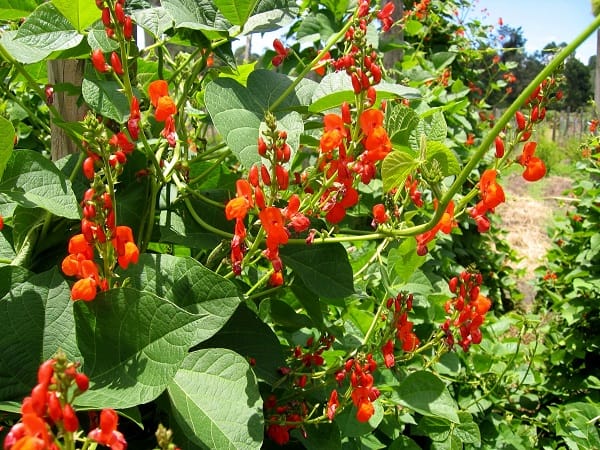

- Golden nectar. The flowers are orange and the long asparagus pods are yellow. Don't wait for these beans to become overripe - pick them off before they're too tough.
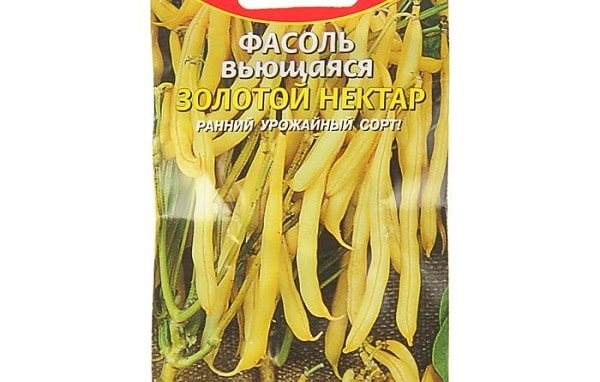

- Turkish beans. Another problem-free variety with fiery scarlet flowers (thanks to them, this beans can also be called Fiery Red). Although the latest varieties of such beans can already delight with white, and two-colored, and salmon, and even burgundy petals. Shoots of such a vine can grow up to 3 and up to 4.5 meters. If this crop is planted early, it will bloom from mid-June to the last weeks of September. The green pods of these beans are not edible.
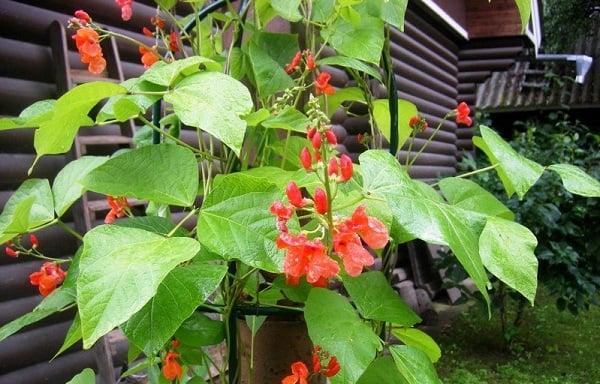

- Winged beans (asparagus peas). In the homeland of culture, in Thailand, they eat everything - beans, pods, flowers, and even the leaves of such beans. The tetrahedral pods of amazing length are the main decorative decoration of this plant.
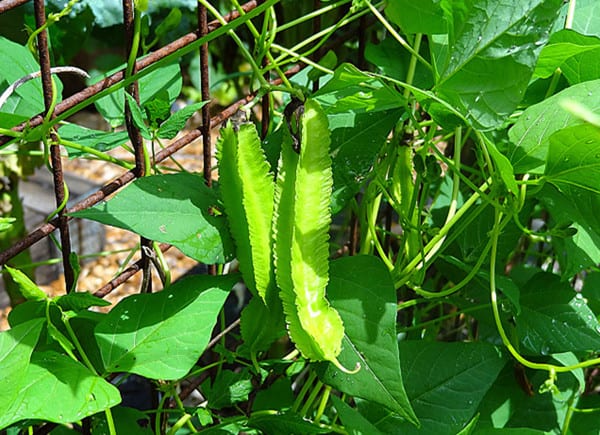

- Bluhilda (or Blauchilda, curly asparagus). An early ripe variety with catchy purple pods.
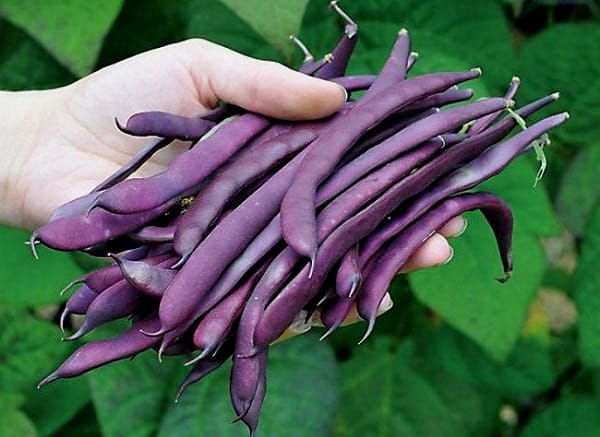

- Mammoth. The flowers of this variety are white, unusually large.
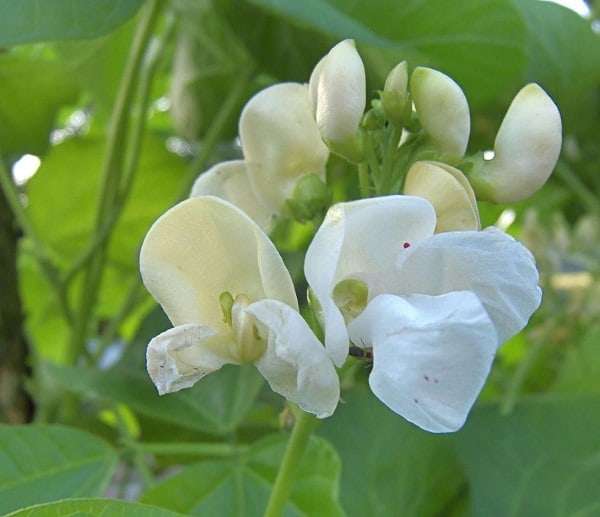

- Fashionista. 100% vegetable grade. Its decorativeness lies in the spotted pods: they are of a light shade, covered with pink or red spots. Similar varieties: Jimenez, Flamingo.
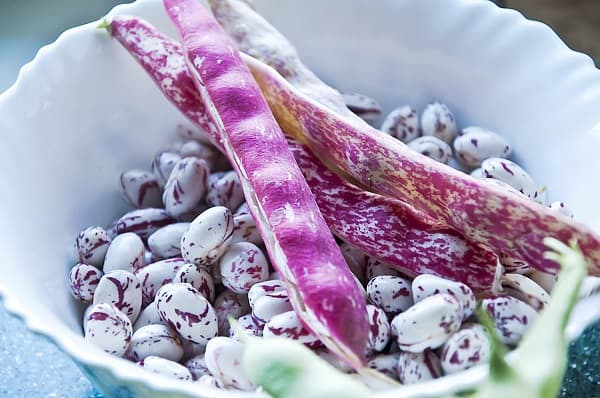

- Vigna caracalla. Vigna is no longer a variety, but a type of beans. The shoot of such a vine grows up to 7 meters. It blooms in clusters of 5-12 large, interestingly swirling white, cream, yellow, purple or violet flowers. These varieties can also be grown on the balcony. And if the balcony is closed, the plant will be perennial - of course, provided that it is warm on your balcony in winter.
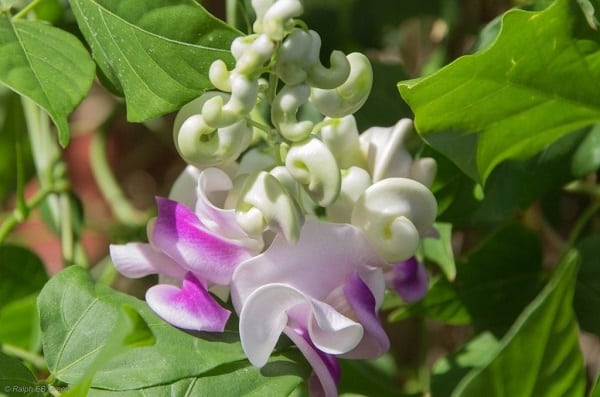

- Dolichos purple (purple beans). Dolichos is not a variety, but also a species - a beautiful representative of the legume family. It is also called curly lilac or hyacinth beans. It is grown both outdoors and in a balcony box. Dolichos vines grow up to 1.5 - 3 meters. Flowers can be not only purple, but also white, pink, two-colored; sometimes even the leaves of the creeper turn out to be purple in color. And most importantly, the flowers smell very nice.
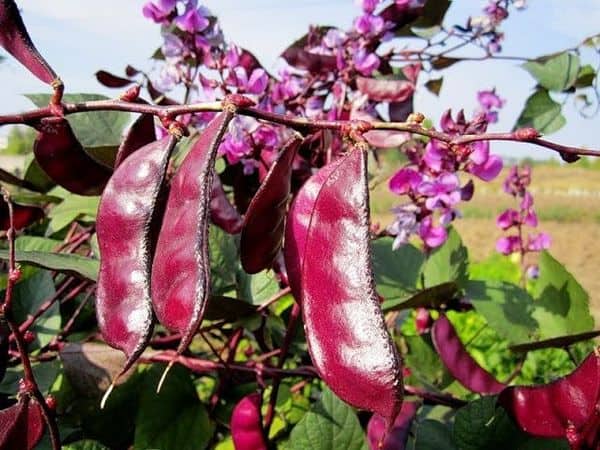

Care
Caring for beans is simple and includes systematic loosening of row spacings, weeding, feeding and watering. Loosening is performed after each watering and rain, it is combined with the removal of weeds. With the growth of the bushes, it will be more and more difficult to loosen it, so it is advisable to mulch the garden. When the bushes grow up to 12-15 cm, they are slightly covered with earth.
Beans are a thermophilic plant, therefore, if they are planted too early, at first you need to monitor the weather and, possibly, cover the plantings with non-woven materials. Alternatively, you can build a small temporary greenhouse. Mature plants can withstand temperatures close to 0 ° C.
How to water beans
All types of beans, including ornamental, are watered infrequently and in moderation, avoiding overdrying of the soil. This should be done at the root, in the evenings, with water settled and warmed up by the sun during the day. In case of dry weather, watering is required twice a week.
It is advisable to direct the water directly to the roots, taking particular care not to soak the flowers and buds. Therefore, a strainer is often removed from the watering can so that water gets between the rows or, in a single-row planting, closer to the base of the bushes.
Immediately before flowering, the soil can be slightly dried for several days: this causes the appearance of more buds, but then watering continues as usual. It is better to mulch the soil around the beans with any loose material (peat, humus, sawdust, chopped straw) in order to better retain moisture.
Top dressing
Ornamental beans are fed with any mineral or natural fertilizers, except for fresh manure. Florists advise to fertilize it only twice:
- With the growth of two true leaves (1 g of urea, 15 g of superphosphate and 10 g of any potassium salt are added per 1 m2).
- At the moment the buds appear (the same composition, excluding urea).
If it turns out that the flowering is not as lush as expected, perhaps the soil is depleted, and in this case, additional feeding should be given by stirring a handful of wood ash and a couple of tablespoons of superphosphate in a bucket of water, then let it stand for a day, diluted in 2 more –3 times with water and pour over the planting solution with this solution.
What are the beans
In appearance, the fruits of beans cannot be confused with beans and peas: a flattened shape, a varied color.
In terms of composition, they are not inferior to beans, but they lose to it in taste and culinary qualities.
100 g of beans contain:
- proteins - 26 g (35% of the daily value);
- fats - 1.53 g (2% of the daily value);
- carbohydrates - 58 g (19% of the daily value);
- water - 11 g;
- ash - 3 g.
The calorie content of 100 g of the product is 341 kcal. The combination of vitamins - groups B, A, PP, C, E - and trace elements - sodium, phosphorus, potassium, iron, zinc - make the product indispensable in dietary and baby food.
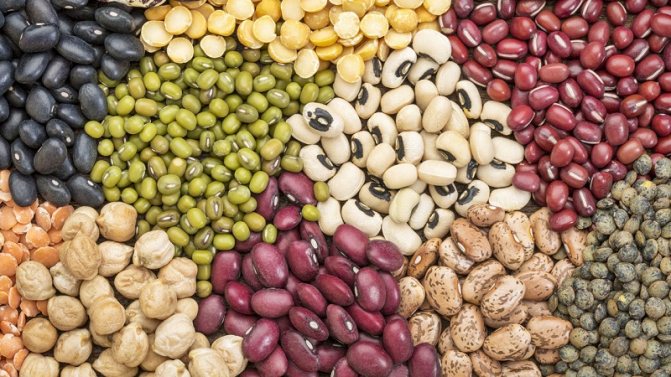

Why beans are good for humans:
- neutralize preservatives, since the composition contains molybdenum;
- daily consumption of 100-150 g of beans lowers cholesterol;
- remove heavy metals and radionuclides, which is important for everyone;
- B vitamins improve brain function;
- vitamins PP, K, C soothe and relieve stress.
The vegetable causes flatulence. It should be used with caution by people with gastrointestinal problems. Undercooked and uncooked beans, especially black beans, cause severe food poisoning.
Important! Beans do not accumulate nitrates and are considered an environmentally friendly product.
For economic purposes, plants are divided into vegetable (food, garden) and fodder.
Gardener Tips
Bean pods are plucked when they are tender and have not reached their maximum toughness. This is important if the pods are being prepared for long-term maturation. Store the pods in the freezer in a plastic bag.
If the beans prepared for eating are not used immediately, but after some time, then they are stored in the refrigerator on the lower shelf. It is also packed in a plastic bag. Several napkins are placed in it in order to prevent condensation from forming. Before putting the beans in the bag, wash them. The napkins should be changed about once a day. This will allow the beans to last longer. Before using the product, you need to open the bag and let the pods "breathe".
Sometimes the soil on which beans grow is poor and needs to be enriched with various minerals. They enrich the soil for the sake of the beans themselves, and so that other plants grow after it the next year. To do this, use a green infusion (common mullein) in a ratio of 1:10.
Important! It must be carefully and in small quantities added to the ground in order to prevent burns on the plant.
Beans have long taken a strong place not only on tables and store counters, but also on hedges, decorating many summer cottages. It is difficult to imagine a person who has never seen curly beans and does not have warm feelings for the walls braided by them. It decorates plots and houses so well that many people cannot even think about using another plant instead.
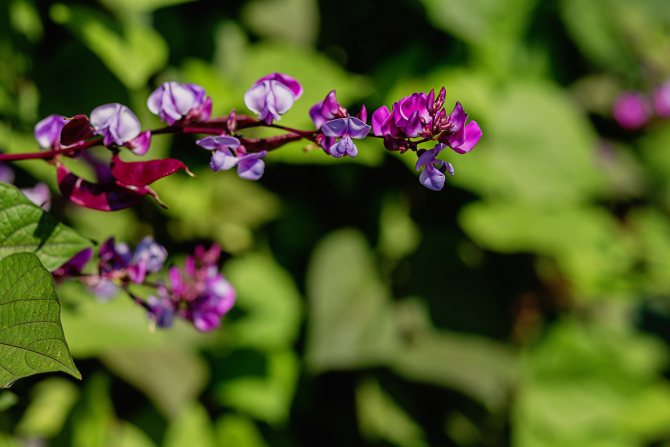

For many years, people have been using many varieties of grain and green beans for food, as a forage crop for pets or for improving the soil, like green manure. But decorative curly beans have a different role. It is grown in the garden as a decoration. Due to its uncomplicated planting, easy care and rapid reproduction, this plant is especially loved by gardeners.

